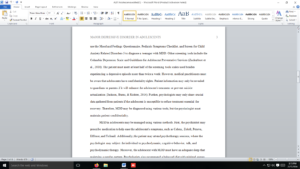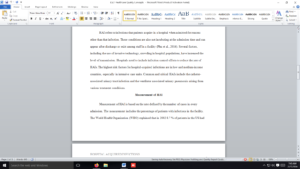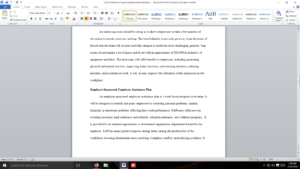Aspect of healthcare leadership
HCAD 635 Discussion 1 Questions –
Instructions: Please answer using your own words in a minimum of 500 words (2-3 paragraphs). PER QUESTION 6 in total. Referenced with two (3) peer-reviewed journal articles or qualified text publish within the past five years and follow APA Manual 6th or 7th editions scholarly writing guidelines. APA in-text Citation formatting is required. When writing replies, please provide your experiences, new ideas, add probing questions to engage readers and new literature on the topic to enhance the learning opportunity.
Questions:
1.1. The LTC Continuum
Let us begin by exploring the “big picture” view of Long Term Care (LTC). Seventy percent of people 65 and over will need some form of LTC service during their lifetimes. Take some time to review these two sites listed in the class schedule: Genworth 2019 Cost of Care and 2019 Alzheimer’s Association Facts and Figures.
What are your initial im
pressions? Discuss why understanding LTC is an important aspect of healthcare leadership. Support your opinions with valid references.
1.2. The LTC Continuum – 1
Care at Home, Community Based Programs and Services, Naturally Occurring Retirement Communities, Assisted Living, Continuing Care Retirement Communities, and caregiver issues. Your Answer should be in the form of a case study analysis. Here is an example of how to format one: https://writingcenter.ashford.edu/writing-case-study-analysis You can use another similar approach or a variation of this example.
Consider this scenario, a composite of actual circumstances.
Bob and Mary were happy when their military service ended, they married and embarked on their civilian careers. Bob and Mary were healthcare professionals; Bob was a professor at the local medical school and Mary was a hospice nurse. Bob and Mary were always active in their church and volunteered their time in the community. They both retired at age 65 to pursue their dream of domestic and international travel. During the early years of their retired life, the couple continued to work part time, travel extensively, and spend time with their grandkids. When Mary turned 78 years of age Bob noticed that she was having memory problems.
Mary always kept up on the latest topics and was always the first to complete the crossword puzzles and other logic games in the newspaper. However, Mary seemed to become increasingly forgetful; she would run errands to purchase specific items and return home empty-handed. The couple decided to seek help from a gerontologist. An extensive battery of cognitive and neuropsychological tests determined that Mary’s language skills and mental abilities had markedly diminished. Mary was diagnosed with Alzheimer’s disease, an incurable terminal brain disease. After the initial shock of the diagnosis, the couple developed a plan that included Bob serving as Mary’s sole caregiver.
Over time, the disease progressed making it difficult for Bob to meet Mary’s needs. In addition, the progression of the disease was tough for both Bob, the children and grandchildren to witness. At first Mary became confused, then she became progressively irritable and aggressive. Five years after the diagnosis, Mary became almost totally withdrawn. Her appetite was nonexistent, and she became incontinent. Additionally, Mary was diagnosed with “sundowners’ syndrome” – a phenomenon whereby the individual experiences confusion and exasperation during the late afternoon or early evening hours.
Bob struggled to care for her and keep an upbeat attitude; however, he too was experiencing health issues due to aging. Bob was a competitive runner for years which impacted his knees and other joints. At times, this condition prevented him from daily activities, self-care and taking care of Mary.
Bob eventually hired a home health aide to visit daily to assist Mary and also do some light household chores. As Mary’s condition grew more serious, he had to make a decision. He was no longer able to care for her, and his own ailments were starting to severely impact his ability to take care of himself.
Bob and Mary had no assets and their retirement savings was gone. They were forced to ask for financial assistance from their children. Luckily, their children were professionals and able to assist Bob and Mary financially. The family had a meeting and agreed that Bob and Mary need to move into a home where they can both get the care that they need.
Questions
- What are the requirements necessary to access the care you have chosen in Question 1?
- What funding mechanisms are available to Bob and Mary, and how does this affect the choice of their care options?
- What could Bob and Mary have done to plan their care during their later years?
- What is your plan to prepare for the possibility of your need for long-term care?
1.3. The LTC Continuum – 2 Caregivers
Skilled Nursing Facilities, Palliative Care, Hospice and End of Life Care.
You have been hired as a consultant to the city government to conduct a survey of caregivers. Who will you define as a caregiver? How will you pick your sample? What will you ask? What are the salient issues that you will want to cover?
1.4. Assessing Quality of Care
What are the major strengths and weaknesses of the nursing home survey process in assuring that residents have high levels of quality of care and quality of life?
1.5 Beyond the Four Walls
What do you consider to be the key areas for developing quality metrics in home and community based care? Which ones are easier to measure than others?
1.6 The Price is Right
Every discussion of Long Term Care eventually arrives at the subject of cost. In preparation for Week 10, test your knowledge on Medicare and Medicaid.
All stakeholders in LTC should strive to understand how both Medicaid and Medicare are implemented.
After testing your knowledge, review Medicare at 50 – Origins and Evolution. Share three insights from your review.
Answer preview
Currently, the cost of LTC stands at $51,480, and even though these costs are less than those of institutionalization, the steep rise in prices is alarming (Genworth, 2019). Asking for assistance, especially when seeking to perform basic tasks such as eating and bathing, is not easy. Understanding how long term care works will allow patients to relinquish control over their lives without feeling useless or worthless. People who have Alzheimer’s disease, to some extent, will also require long term care, especially if the disease leads to dementia (Alzheimer’s Association, 2019). The disease affects certain sections of the brain, which adversely affects both the short term and long term memory, which means that remembering simple tasks such as when to take medications, take a bath, or eat, will be quite difficult (Alzheimer’s Association, 2019). Such people need full-time caregivers who will ensure they take their medication, eat, and bathe on time. They might initially decline this type of care. However, explaining and showing them why they need long term care might help ease some of their concerns, enabling them to be more open to having someone fully take care of them.
[3653 Words]
Aspect of healthcare leadership











